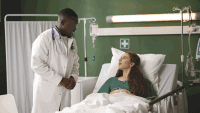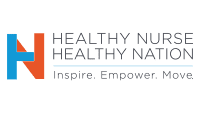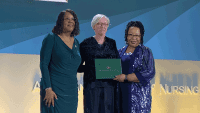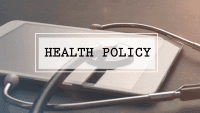One hospital’s strategy for success.
Takeaways:
- Building a strong organizational infrastructure to support and empower nurses in their practice environments is essential to successfully meet the requirements of the Magnet Recognition Program®.
- Learn how a successful organization operationalizes structural empowerment and uses continuous improvement to demonstrate empirical outcomes.
The American Nurses Credentialing Center’s (ANCC) Magnet® model is a multifaceted framework for evaluating healthcare organization excellence. The structure and process for each component of the model—Transformational Leadership (TL); Structural Empowerment (SE); Exemplary Professional Practice; and New Knowledge, Innovations, and Improvement—must be demonstrated independently. All components intersect at the model’s core—Empirical Outcomes (EOs)—which qualitatively and quantitatively measure each component’s impact on the patient, nursing workforce, organization, and consumer.
The SE component validates the presence of an organization infrastructure that empowers nurses to participate in decision-making, supports professional development through lifelong learning, demonstrates a commitment to advancing community health, and recognizes nurses’ valuable contributions.
St. Louis Children’s Hospital (SLCH) is a 390-bed pediatric hospital within the BJC HealthCare system, in partnership with Washington University’s School of Medicine. SLCH received its first Magnet designation in 2005 and received its fourth designation in April 2020. This article shares how SLCH operationalizes some of the most challenging SE sources of evidence.
Professional development
Building a structure for nurses to participate in decision-making at the unit and organizational levels is paramount. Many of the sources of evidence related to improved patient outcomes originated from the work of shared leadership councils.
Shared leadership (SE1EO)
To promote professional nursing practice, nurse autonomy, and decision-making across all practice settings, SLCH developed six leadership councils modeled on a shared governance concept. Four are interprofessional councils with representatives across all clinical disciplines, including clinical nurses, and two are composed exclusively of nurses. These councils facilitate decision-making and creative innovation, resulting in an enhanced work environment and improved patient outcomes. (To view a list of SLCH’s shared leadership councils, click here.)
Unit-based joint practice teams are one example of SLCH’s shared leadership. Each patient care area is managed by an interprofessional team co-led by a physician and a nurse, with direct care staff from all clinical disciplines. The teams are supported by the shared leadership councils, providing an opportunity for open communication about safety, clinical, educational, and practice issues. Team improvement efforts frequently impact clinical outcomes and patient satisfaction scores.
In addition, four organizational-level interprofessional teams—central line-associated bloodstream infection team, surgical site infections team, skin and wound committee, and falls team—made up of clinical nurses from inpatient and ambulatory departments, director and executive sponsors, quality and safety specialists, ancillary professionals, and physicians (on select teams) collaborate to improve patient outcomes. Nurses co-lead each team and collaborate to review data, evaluate trends, identify barriers, and design and implement solutions using process and quality improvement methodology.
Professional organizations (SE2EO)
Nurses have an obligation to advance the nursing profession. One way to accomplish this is through affiliations with or participation in professional organizations that elevate practice and education standards through advocacy, communication, professional knowledge dissemination, and professional development opportunities.
Professional organization affiliation (SE2EOa) gives nurses who may not be members access to journal articles or other resources of the nursing or non-nursing organization. Organizations may publish evidence-based practice recommendations that nurses can review and share with their healthcare teams and potentially incorporate into nursing practice.
Participation in a professional organization (SE2EOb) implies the nurse is a member and has gained access to its scope and standards of practice and incorporated one or more elements into nursing practice. Membership benefits may include exclusive access to member-only resources or special pricing to attend organization-sponsored conferences.
When nurses are mentored in evidence-based practice or research at SLCH, they’re coached to use literature searches to review recommendations and standards of practice made by professional organizations. When nurses apply for funding to attend conferences sponsored by professional organizations, nurses who are organization members are given preference.
Teaching and role development
Consistent with American Nurses Association standards of professional performance, nurses are obligated to attain knowledge and competency consistent with current nursing practice. Organizations must demonstrate a commitment to provide these opportunities, addressing areas of interest and needed development.
Education needs assessment (SE8EO)
SLCH identifies topics for educational programming using a biennial education needs assessment administered to all nursing and ancillary professional staff. The interprofessional shared leadership education council designs and administers the survey, which includes topics on patient safety, error prevention, behavioral health, complex patient/family needs, and professional/safe work environments. Results are synthesized two ways: They’re combined to identify organizational learning needs, and they’re analyzed by profession. Nurse data are further stratified by nurse role and practice setting, then shared at the unit level. Unit-based clinical nurse educators develop unit-level programming based on needs assessment results.
Beginning in 2020, SLCH nurse educators were encouraged to administer an additional unit-based clinical practice education needs assessment. Based on identified needs, they then used a standardized template to create a customized implementation plan with educational activities and timelines, linking each activity to a measurable outcome when possible. This format facilitated easy example selection for each source of evidence for the Magnet document.
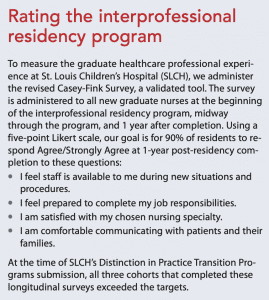 Transition to practice (SE9)
Transition to practice (SE9)
To support a healthy workforce and ensure adequate acclimation to a new work environment, nurses must be supported during key practice transitions—new graduates, newly hired experienced nurses, nurses transferring within the organization to a new practice environment, nurses transitioning into an advanced practice role, and nurse managers moving into a new role.
In July 2019, the ANCC awarded Accreditation with Distinction in Practice Transition Programs to the SLCH interprofessional residency program (a unique program for entry-level clinicians from various disciplines including nursing). The residency program for new graduate nurses incorporates SLCH’s Support for Success transition-to-practice and mentoring programs with comprehensive hospital, general nursing, and unit-based nursing orientations. The clinical education department oversees the interprofessional residency program and nursing orientation process, and two clinical nurses oversee the mentoring component (TL6a). (See Rating the interprofessional residency program.)
Commitment to community involvement
Hospitals should support the health needs of their communities, and non-profit institutions are required to demonstrate how they use their nontaxable revenue to benefit these communities. Nurses can help meet these goals with their commitment to programs that improve the public’s health and well-being.
Delivering culturally and socially sensitive care (SE11)
In St. Louis, 48% of residents describe themselves as Black and 43% as White; the SLCH nursing workforce is 90% White and 4% Black. To address cultural differences, nurses at SLCH have been encouraged to identify opportunities to improve the cultural sensitivity of care to Black patients and families and are empowered to act to address those disparities.
Clinical nurses identified that appropriate hair care products for Black patients weren’t available and that White nurses were unfamiliar with how to care for hair different from their own. As a result, nurses used either inappropriate products or didn’t provide hair care at all. A diverse hair care team was convened to develop a plan to increase clinical nurses’ cultural competence in providing hair care to Black patients. The team included Black nurses and staff from SLCH’s community outreach programs and human resources to provide guidance.
The SLCH chief nursing officer offered support and guidance for the work and advocated for new products recommended by the team to be approved for addition to the BJC supply chain. The team produced an education module with an embedded video and a survey to understand nurse perceptions about caring for Black hair and also developed an ambassador role to assist with communication and implementation. The video provided a historical perspective on the importance of hair care in the Black community, described the gap in culturally competent care provided to Black families, shared family concerns about lack of hair care, and established an expectation with organization leaders and clinicians to complete a learning module that underscores why Black hair care is important. SLCH received an exemplar for this work during its recent Magnet redesignation.
Recognition of nursing (SE12)
Building key elements of the source of evidence into award criteria and standardizing how winners are publicly recognized make it easy to identify examples for the Magnet document. For instance, in 2019, criteria for the Excellence in Nursing Leadership Award were modified to align with SE12 (recognition of a clinical nurse for contributions in addressing the strategic priorities of the organization). Revised criteria recognize a nurse who champions change and innovation and then leads a project resulting in a successful outcome that aligns with one or more of SLCH’s five strategic priorities (our true north metrics: quality & safety, service, access & delivery, stewardship, and engagement).
Embrace improvement
Building a strong organizational infrastructure to support and empower nurses in their practice environments is essential to successfully meet the requirements of the Magnet model SE component. At SLCH, we embrace ongoing improvement and efficiency and strive to intentionally design standard practices to achieve excellence, which translates to building exceptional examples for our document.
The authors work at St. Louis Children’s Hospital in St. Louis, Missouri. Peggy Gordin is vice president of patient care services and chief nursing officer. Heidi Fields is an advanced practice nurse and Magnet program director.
References
American Nurses Association. Nursing Scope and Standards of Practice. 3rd ed. Silver Spring, MD: American Nurses Association; 2015.
American Nurses Credentialing Center. 2019 Magnet Application Manual. Silver Spring, MD: American Nurses Credentialing Center; 2017.
Matthews JH. Role of professional organizations in advocating for the nursing profession. Online J Issues Nurs. 2012;17(1):3.







